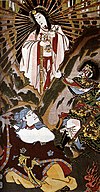
The Grand Shrine of Ise, located in Ise, Mie Prefecture of Japan, is a Shinto shrine dedicated to the solar goddess Amaterasu. Officially known simply as Jingū (神宮), Ise Jingū is a shrine complex composed of many Shinto shrines centered on two main shrines, Naikū (内宮) and Gekū (外宮).

In Shinto and Buddhism in Japan, an ofuda is a talisman made out of various materials such as paper, wood, cloth or metal. Ofuda are commonly found in both Shinto shrines and Buddhist temples and are considered to be imbued with the power of the deities or Buddhist figures revered therein. Such amulets are also called gofu (護符).

A Shinto shrine is a structure whose main purpose is to house ("enshrine") one or more kami, the deities of the Shinto religion.

Ōyama-tsumi or Ohoyama-tsumi, also Ōyama-tsumi-mi'oya-no-mikoto (大山祇御祖命), is a god of mountains, sea, and war in Japanese mythology. He is an elder brother of Amaterasu and Susanoo. His other names are Watashi-no-Ōkami (和多志大神) and Sakatoke (酒解神).
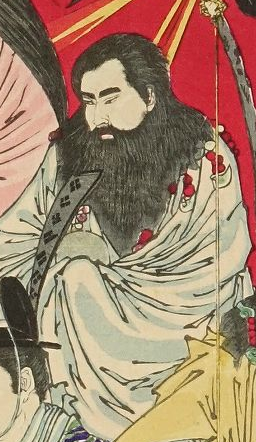
Ninigi-no-Mikoto is a deity in Japanese mythology. Grandson of the sun goddess Amaterasu, Ninigi is regarded according to Japanese mythology as the great-grandfather of Japan’s first emperor, Emperor Jimmu. The three sacred treasures brought with Ninigi from Heaven and divine ancestry established the Japanese Imperial Family.

Ugayafukiaezu no Mikoto (鵜葺草葺不合命) is a Shinto kami, and is in Japanese mythology, the father of Japan's first Emperor, Emperor Jimmu.
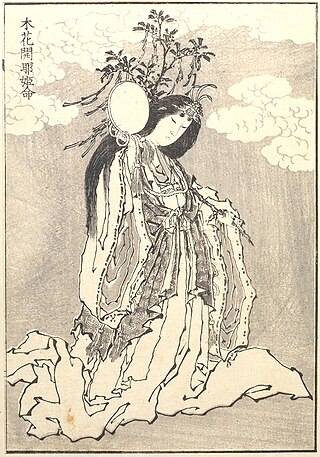
Konohanasakuya-hime is the goddess of Mount Fuji and all volcanoes in Japanese mythology; she is also the blossom-princess and symbol of delicate earthly life. She is often considered an avatar of Japanese life, especially since her symbol is the sakura.
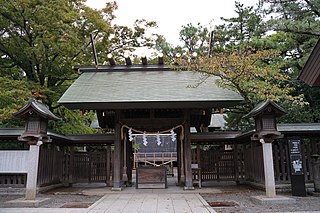
Ōhi Shrine, also known as Funabashi Daijingū (船橋大神宮), is a Shinto shrine dedicated to the sun goddess Amaterasu located in the city of Funabashi in Chiba Prefecture, Japan.

Toyouke-hime is the goddess of agriculture, industry, food, clothing, and houses in the Shinto religion. Originally enshrined in the Tanba region of Japan, she was called to reside at Gekū, Ise Shrine, about 1,500 years ago at the age of Emperor Yūryaku to offer sacred food to Amaterasu Ōmikami, the Sun Goddess.
The Engishiki is a Japanese book about laws and customs. The major part of the writing was completed in 927.
In Japanese mythology, the tenson kōrin (天孫降臨) is the descent of Amaterasu's grandson Ninigi-no-Mikoto from Heaven (Takamagahara) to Ashihara no Nakatsukuni; according to legend, the direct place of descent is at Takachiho-gawara in Japan. Following the tenson kōrin, Ninigi's son, Hoori, was born.

In Japan, a chinjusha is a Shinto shrine which enshrines a tutelary kami; that is, a patron spirit that protects a given area, village, building or a Buddhist temple. The Imperial Palace has its own tutelary shrine dedicated to the 21 guardian gods of Ise Shrine. Tutelary shrines are usually very small, but there is a range in size, and the great Hiyoshi Taisha for example is Enryaku-ji's tutelary shrine. The tutelary shrine of a temple or the complex the two together form are sometimes called a temple-shrine. If a tutelary shrine is called chinju-dō, it is the tutelary shrine of a Buddhist temple. Even in that case, however, the shrine retains its distinctive architecture.

Kasai Shrine (葛西神社) was the head shrine of eleven towns in the region and is classified historically as a district shrine (郷社). It is located in Higashi Kanamachi, Katsushika ward, Tokyo.

Amenooshihomimi (天忍穗耳尊,天之忍穂耳命) or Oshihomimi for short, is the first son of Amaterasu.
Takamimusubi is a god of agriculture in Japanese mythology, who was the second of the first beings to come into existence.
Hosuseri (火須勢理命) is a god that appears in Japanese mythology. Second child of Ninigi-no-Mikoto and Konohanasakuya-hime. He is considered to be the great-uncle of Emperor Jimmu.
Jingūkyō (神宮教) is a sect of Shinto that originated from Ise Grand Shrine, the Ise faith. It was not technically a Sect Shinto group but had characteristics of one. It was founded in 1882, and was reorganized into the Jingū Service Foundation in 1899.
Inahi no Mikoto was a Japanese legendary character. In Japanese traditional mythology, he was a brother of Emperor Jimmu, the first Emperor who according to tradition lived in the 7th century BC. His name Inahi means "boiled rice".
Takuhadachiji-hime (栲幡千千姫命), is a deity that appears in the creation story of the "Kojiki" and "Nihon Shoki." She is the daughter of the god Takamimusubi and younger sister of Omoikane. She is the goddess of textiles and mother of Ninigi-no-Mikoto and Amenohoakari, and thus an ancestor of Jimmu.
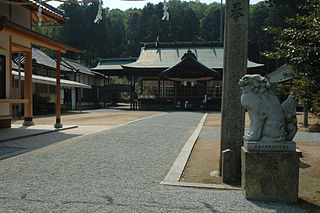
Ani Shrine (安仁神社) is a Shinto shrine located in Okayama City, Japan. It is an Imperial ancestral shrine. It is a Beppyo shrine, or a shrine that is particularly notable in a certain way with a significant history to it.














